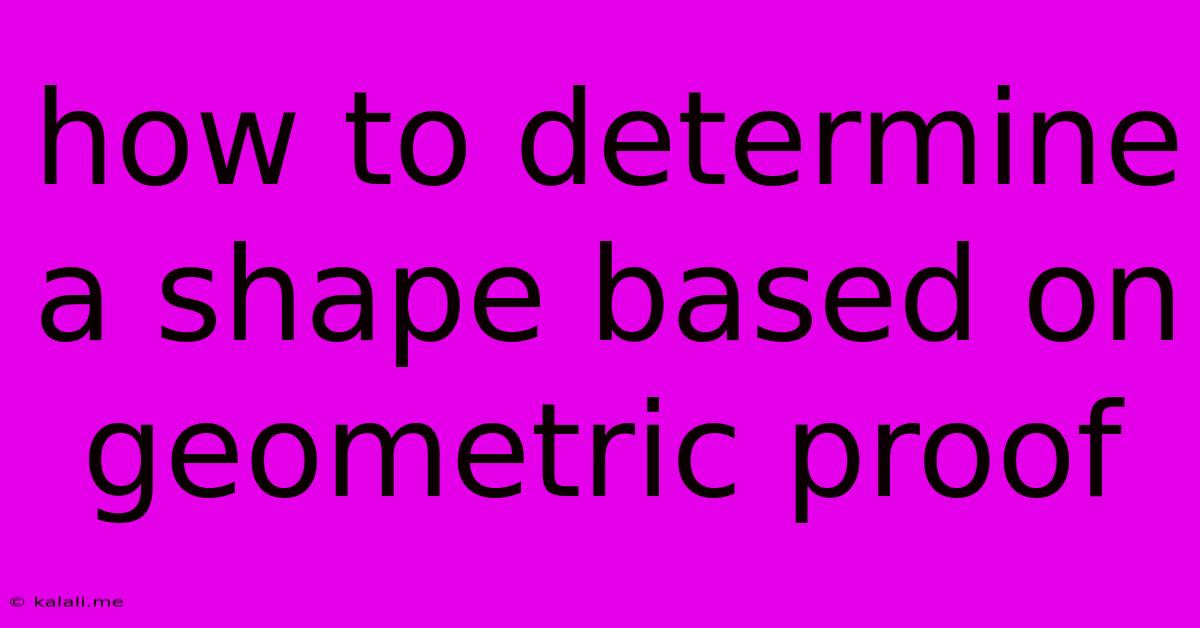How To Determine A Shape Based On Geometric Proof
Kalali
Jun 03, 2025 · 3 min read

Table of Contents
How to Determine a Shape Based on Geometric Proof
Determining the shape of a geometric figure solely based on its properties requires a solid understanding of geometric principles and proof techniques. This process often involves analyzing given information—like side lengths, angles, or relationships between lines—to deduce the figure's classification. This article will explore various methods and examples to help you master this skill.
Understanding Geometric Shapes and Their Properties
Before diving into proofs, it's crucial to have a strong foundation in geometric shapes and their defining characteristics. Key shapes and their properties include:
-
Triangles: Classified by side lengths (equilateral, isosceles, scalene) and angles (acute, right, obtuse). Properties like the Pythagorean theorem (for right triangles) and triangle inequality theorem are essential.
-
Quadrilaterals: This broad category includes squares, rectangles, rhombuses, parallelograms, trapezoids, and kites. Each has specific properties regarding parallel sides, congruent sides and angles, and diagonals.
-
Circles: Defined by a single point (center) and a constant distance (radius) to all points on the circumference. Properties involve chords, tangents, and central angles.
-
Polygons: Shapes with three or more sides. Regular polygons have congruent sides and angles.
Methods for Determining Shapes Through Proof
Several strategies are employed when proving the shape of a geometric figure:
1. Direct Proof: This involves directly applying definitions and theorems to the given information to conclude the shape.
Example: Prove that a quadrilateral with four congruent sides and four right angles is a square.
- Given: Quadrilateral ABCD with AB = BC = CD = DA and ∠A = ∠B = ∠C = ∠D = 90°.
- Proof: By definition, a quadrilateral with four congruent sides is a rhombus. A quadrilateral with four right angles is a rectangle. Since a square is a quadrilateral that is both a rhombus and a rectangle, ABCD is a square.
2. Proof by Contradiction: Assume the opposite of what you want to prove, and then show that this assumption leads to a contradiction.
Example: Prove that if a triangle has two congruent sides, it is an isosceles triangle.
- Given: Triangle ABC with AB = AC.
- Proof: Assume ABC is not an isosceles triangle. This implies that AB ≠ AC. However, this contradicts the given information (AB = AC). Therefore, our assumption is false, and ABC must be an isosceles triangle.
3. Using Congruence and Similarity: Prove that triangles or other shapes are congruent or similar, and then use corresponding parts to determine properties of the original shape.
Example: Prove that the diagonals of a parallelogram bisect each other.
- Given: Parallelogram ABCD with diagonals AC and BD intersecting at point E.
- Proof: We can prove that triangles ΔABE and ΔCDE are congruent (using ASA or SAS congruence postulates). This proves that AE = CE and BE = DE, showing that the diagonals bisect each other.
4. Utilizing Coordinate Geometry: Assign coordinates to vertices and use distance and slope formulas to prove properties.
Example: Prove that a quadrilateral with vertices A(0,0), B(a,0), C(a+b,c), D(b,c) is a parallelogram.
- Proof: By calculating the slopes of AB, BC, CD, and DA, you can show that opposite sides are parallel. Similarly, the distance formula can verify that opposite sides are equal in length.
Important Considerations:
- Clearly State the Given Information: Begin each proof by explicitly stating the given facts.
- Define Your Terms: Use precise mathematical language and definitions.
- Logical Steps: Each step in your proof must follow logically from the previous step.
- Justify Your Statements: Cite theorems, postulates, or definitions to support your assertions.
- State Your Conclusion: Clearly state what you have proven.
By mastering these methods and consistently practicing geometric proofs, you'll develop the skills needed to confidently determine the shape of a geometric figure based on its properties. Remember, practice is key to honing your logical reasoning and problem-solving abilities in geometry.
Latest Posts
Latest Posts
-
What Did God Crate The Water
Jun 05, 2025
-
How To Stop Opening Up With Launcpad
Jun 05, 2025
-
How Do You Clean Mold Off Concrete
Jun 05, 2025
-
How Do You Know If The Ignition Coil Is Bad
Jun 05, 2025
-
Linux Show The File Sort By File Name Length
Jun 05, 2025
Related Post
Thank you for visiting our website which covers about How To Determine A Shape Based On Geometric Proof . We hope the information provided has been useful to you. Feel free to contact us if you have any questions or need further assistance. See you next time and don't miss to bookmark.